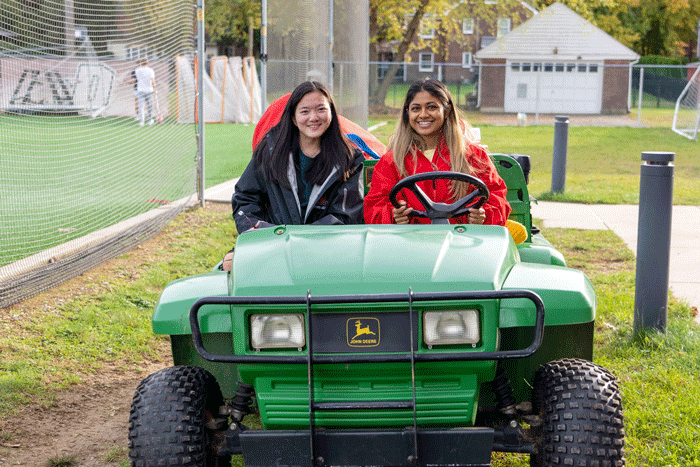Sports-Medicine Student Assistant Program Helps Keep Athletes on the Field

Jade Heenehan '24 (left; environmental studies) and Misa Patel '22 (physics) set out for the day as sports-medicine student assistants. Photo by Dan Loh.
hands-on opportunity offers valuable work-study experience, on-ramp to the medical field
by Tony Moore
Dickinson has 12 men’s and 13 women’s varsity sports, and it takes a knowledgeable training staff to make sure every Red Devil remains as injury-free and healthy as possible—and gets quick care when one of them goes down in action.
To supplement that staff, the Department of Athletics hires work-study students as sports-medicine student assistants (SMSA). And the experience these SMSAs accumulate prepares them to care for athletes on the sidelines and in training facilities, quickly making them vital members of the training staff.
“Our students are an invaluable part of our athletic programs here at Dickinson,” says Janelle Nolt, Dickinson’s head athletic trainer, noting that the daily tasks the SMSAs handle free up training staff to do other important work with the teams. “We couldn’t provide the same level of care to our student-athletes without their assistance.”
Nolt says that students don’t need experience in the athletics training field or have to want to enter the field upon graduation to become an SMSA. But they’ve had many students who have gone on to careers in physical therapy, orthopedics, athletic training, exercise science and other related fields.
“I had an interest in science, and I was a student-athlete myself, so the sports medicine program and work-study job seemed to be a perfect fit melding the two,” says Andrea Carlow Bickford ’04, who worked at an athletic training facility for five years before becoming a doctor of physical therapy and board-certified orthopedic clinical specialist. “My sports medicine background at Dickinson was extremely helpful to my studies and ultimate practice as an athletic trainer, [as it] provided me with knowledge and confidence in treating student-athletes that many of my peers in the athletic training program did not have at the outset of our graduate studies.”
Students in the sports medicine program are not allowed to perform injury evaluations or make decisions regarding athletes’ ability to return to play after an injury, but they are required to have first aid and CPR/AED training and are allowed to administer basic first aid.
“The training program has a good bit of responsibility,” says Lindsey Hollenshead ’24 (international business & management), a basketball player who works the sidelines, wraps ice for fellow athletes and sets up before games and practices. “I’ve loved every minute of it, and I definitely think the skills that I’m learning in this program will help me in my future as an athlete and hopefully a coach at some point.”
Students interested in the field of sports medicine will often spend time shadowing the staff while working with serious injuries or rehab cases and ask questions as they progress, and Nolt has written many letters of recommendations for future PTs, PAs and physicians over the years. And it’s that kind of hands-on experience that makes the program a useful on-ramp for a possible career in medicine.
Kate Montgomery ’23 (neuroscience), a current SMSA, plans on applying to either a physician assistant program or an accelerated nursing program after graduation, with the hopes of one day working in pediatric medicine. And former SMSA Alfredo Axtmayer ’04 made the leap, serving now as a bone marrow transplant and cellular therapy nurse practitioner at Yale New Haven Hospital.
“As an oncology nurse practitioner, I know the importance of a thorough and comprehensive work-up—just like an athlete’s condition can change from practice to practice or game to game, an oncology patient’s condition can deteriorate quickly from one visit to another,” says the former Red Devil soccer player on how his SMSA experience translates over to his career. “I also learned the importance of teamwork and communication. We always communicated with the head trainers and coaches, and now I continue to communicate with oncologists and specialists in different disciples to optimize patient health.”
Students interested in the program—whether to build a solid foundation in sports medicine or to just be involved in Dickinson athletics in a new way—should contact Adam Richmond, athletic trainer and instructor in the Department of Health and Physical Education.
TAKE THE NEXT STEPS
Published December 14, 2021